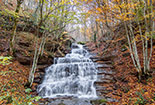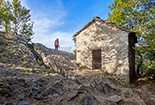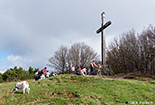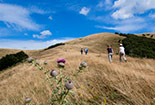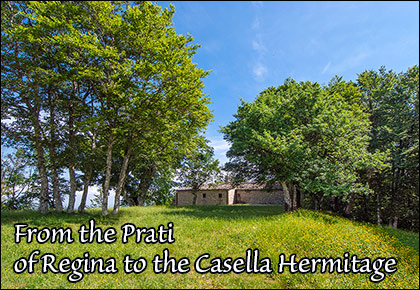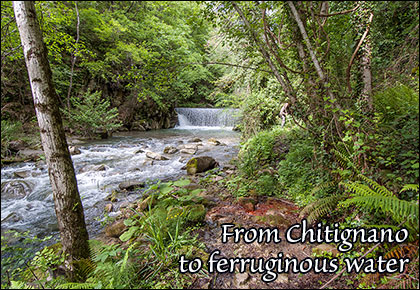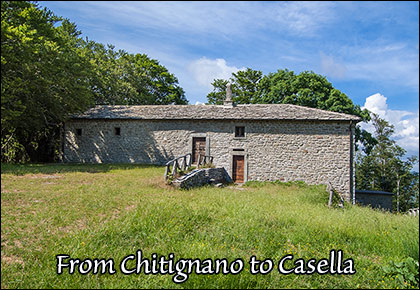Chitignano
in Casentino, a Tuscan valley that you can get to know in every detail through this site
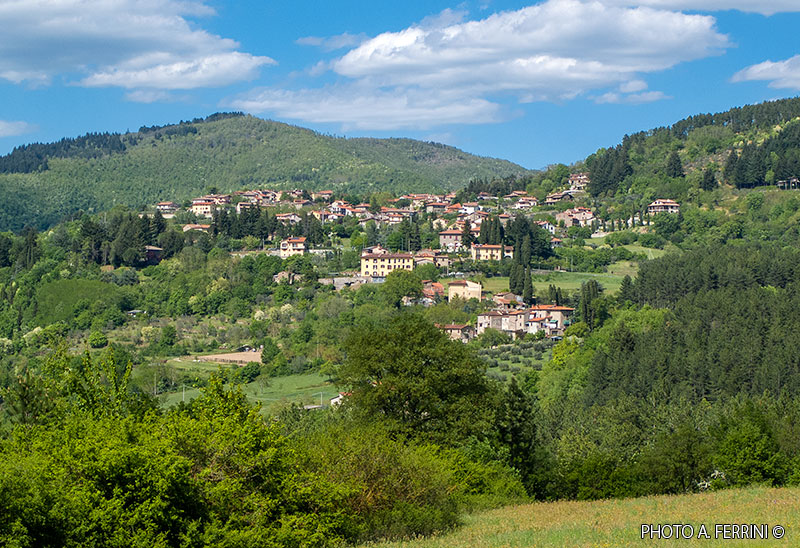
Texts and photos by Alessandro Ferrini ©
80 images in sequence to get to know Chitignano and the paths that lead from the town to the ferruginous water and to La Casella
Chitignano: a castle, thermal waters, the smuggling town
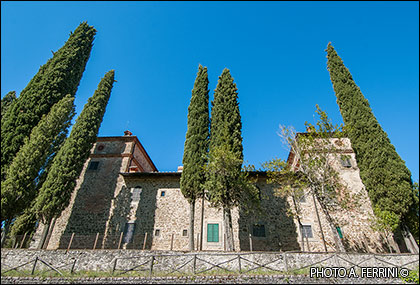 Heading from Rassina towards La Verna, after six kilometers we reach Chitignano, an elongated town that flanks the road. We find his name mentioned for the first time in 967, as Clotinian, when Otto I established a fiefdom here which he assigned to the Counts of Chiusi and Caprese. It was probably these gentlemen who built a first castle in the area (the second will be the one that later became the Ubertini) whose few ruins can be seen on Poggio Giusti using the forest road for 3.7 kilometers (the first 1.4 kilometers passable with a normal car) which leads from the village to the Hermitage of Casella. It will then be a comfortable walk on a detour to the right (closed by a barrier) that will lead us to this place. After about 1.5 kilometres, another right turn and in three hundred meters we will be at the foot of a small hill on top of which there are the remains of the castle. The place is known as Le Mura. The town of Chitignano is relatively modern, in fact, even if its origins date back to the seventeenth century, its important development began between the late nineteenth and early twentieth centuries, favored by the proximity of the Sanctuary of La Verna and the presence of thermal springs in its surroundings. Ferruginous sulfuric waters with proven healing properties of the digestive system, indicated for the purification of the liver and kidneys, the treatment of some skin diseases. In reality, two activities carried out initially legally and then illegally contributed strongly to the development of the country: the processing of tobacco with the creation of cigars and the production of gunpowder. For this reason, in Casentino, Chitignano is known as the town of smugglers. We will elaborate on this topic later. The small village is located between two churches. In the uppermost part we find that of San Lorenzo, very simple, with a tympanum on the facade. In the lower area is the Church of Santi Vincenzo e Pietro built at the beginning of the 17th century. Its architecture is very particular because in the late Baroque period the facade was rebuilt and a portico was added on the left wall. The bell tower, with a clock and a small terrace on top, was built in the mid-nineteenth century. The interior has a single nave with two side chapels. Being a non-ancient village, the nucleus of Chitignano, i.e. the oldest part, has no things of particular historical and architectural interest to show.
Heading from Rassina towards La Verna, after six kilometers we reach Chitignano, an elongated town that flanks the road. We find his name mentioned for the first time in 967, as Clotinian, when Otto I established a fiefdom here which he assigned to the Counts of Chiusi and Caprese. It was probably these gentlemen who built a first castle in the area (the second will be the one that later became the Ubertini) whose few ruins can be seen on Poggio Giusti using the forest road for 3.7 kilometers (the first 1.4 kilometers passable with a normal car) which leads from the village to the Hermitage of Casella. It will then be a comfortable walk on a detour to the right (closed by a barrier) that will lead us to this place. After about 1.5 kilometres, another right turn and in three hundred meters we will be at the foot of a small hill on top of which there are the remains of the castle. The place is known as Le Mura. The town of Chitignano is relatively modern, in fact, even if its origins date back to the seventeenth century, its important development began between the late nineteenth and early twentieth centuries, favored by the proximity of the Sanctuary of La Verna and the presence of thermal springs in its surroundings. Ferruginous sulfuric waters with proven healing properties of the digestive system, indicated for the purification of the liver and kidneys, the treatment of some skin diseases. In reality, two activities carried out initially legally and then illegally contributed strongly to the development of the country: the processing of tobacco with the creation of cigars and the production of gunpowder. For this reason, in Casentino, Chitignano is known as the town of smugglers. We will elaborate on this topic later. The small village is located between two churches. In the uppermost part we find that of San Lorenzo, very simple, with a tympanum on the facade. In the lower area is the Church of Santi Vincenzo e Pietro built at the beginning of the 17th century. Its architecture is very particular because in the late Baroque period the facade was rebuilt and a portico was added on the left wall. The bell tower, with a clock and a small terrace on top, was built in the mid-nineteenth century. The interior has a single nave with two side chapels. Being a non-ancient village, the nucleus of Chitignano, i.e. the oldest part, has no things of particular historical and architectural interest to show. 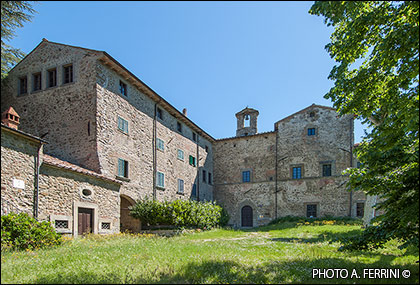 However, it is pleasant and well-kept, a clear testimony of the love that the inhabitants have for their country. The most interesting area of the place is located one kilometer outside the town, along the road towards Rassina. These are the Castello degli Ubertini and the ancient Podesta office. The first was built by the Catani Counts of Chiusi in the 12th century. This family was taken away in 1261 by the Ubertini, the noble and powerful Ghibelline house known for its antagonism against the Florentine Guelphs which at that time had its leading exponent in Guglielmino. He was Bishop of Arezzo and in 1289 will be at the head of the Arezzo troops who clashed with Florence in the Battle of Campaldino. In 1325 the castle passed for a few years into the hands of the Tarlati di Pietramala and then returned to the Ubertini who in 1385 spontaneously submitted to the Florentine Republic. Following this move, Florence allowed Chitignano, while under the control of the city of Giglio, to become a county governed by the Ubertini. This situation lasted until 1799, when the Grand Duke Pietro Leopoldo suppressed the county. Around the middle of the 19th century, the Ubertinis sold the castle which over the centuries had undergone many profound rebuildings, transforming itself into the large palace that we can see today. Opposite the castle, on the other side of the road, is a building with a very particular shape. This is the Podesteria of Chitignano. This was born in the early fifteenth century and originally consisted of only two towers, certainly higher, that we see today on the sides of the building. It is assumed that one was the administrative headquarters, while the gendarmerie resided in the other. The central body of the building was a later addition. As already mentioned, the economic history of Chitignano has been closely linked to smuggling with the processing and marketing of tobacco and the production of gunpowder. The legal production of tobacco has been known since 1799, when, authorized by the Grand Duchy of Tuscany, it was practiced within the County of the Ubertini Counts. This privilege was suppressed in 1830, but Chitignano could not give up this activity which gave so many economic benefits, so it continued clandestinely.
However, it is pleasant and well-kept, a clear testimony of the love that the inhabitants have for their country. The most interesting area of the place is located one kilometer outside the town, along the road towards Rassina. These are the Castello degli Ubertini and the ancient Podesta office. The first was built by the Catani Counts of Chiusi in the 12th century. This family was taken away in 1261 by the Ubertini, the noble and powerful Ghibelline house known for its antagonism against the Florentine Guelphs which at that time had its leading exponent in Guglielmino. He was Bishop of Arezzo and in 1289 will be at the head of the Arezzo troops who clashed with Florence in the Battle of Campaldino. In 1325 the castle passed for a few years into the hands of the Tarlati di Pietramala and then returned to the Ubertini who in 1385 spontaneously submitted to the Florentine Republic. Following this move, Florence allowed Chitignano, while under the control of the city of Giglio, to become a county governed by the Ubertini. This situation lasted until 1799, when the Grand Duke Pietro Leopoldo suppressed the county. Around the middle of the 19th century, the Ubertinis sold the castle which over the centuries had undergone many profound rebuildings, transforming itself into the large palace that we can see today. Opposite the castle, on the other side of the road, is a building with a very particular shape. This is the Podesteria of Chitignano. This was born in the early fifteenth century and originally consisted of only two towers, certainly higher, that we see today on the sides of the building. It is assumed that one was the administrative headquarters, while the gendarmerie resided in the other. The central body of the building was a later addition. As already mentioned, the economic history of Chitignano has been closely linked to smuggling with the processing and marketing of tobacco and the production of gunpowder. The legal production of tobacco has been known since 1799, when, authorized by the Grand Duchy of Tuscany, it was practiced within the County of the Ubertini Counts. This privilege was suppressed in 1830, but Chitignano could not give up this activity which gave so many economic benefits, so it continued clandestinely. 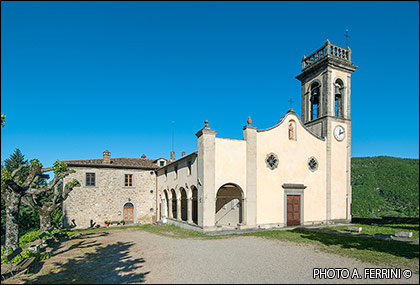 Not only with the production of two types of chopped tobacco, for cigarettes and for pipes, but also with the preparation of "snuff" and cigars. The packaging of the latter was mainly done by women, in their home laboratories. Clandestine sales were practiced mainly in Florence and Romagna, but it also reached Pisa, Livorno, Maremma, upper Lazio, Umbria and the Marches. This activity continued until the fifties of the twentieth century. Even the production of gunpowder began legally in the 1860s and experienced its maximum development between the end of this century and the beginning of the First World War. The authorized powder factories were built along the Rassina stream from where they drew the energy necessary for the movement of the machines, the two main ones being I Ciofi and I Prati. These factories were real industries, relative to the period, and employed many people. Given the profits, these businesses expanded to an individual level, clearly illegally. Always along the stream, but mainly in the woods where it was more difficult for the supervisory authorities to discover them. The so-called "pilli" were made, i.e. rudimentary holes in the rock similar to mortars. Inside them, the components of gunpowder were beaten: coal, sulfur and saltpetre. Already in possession of a few decades of experience, it was generally the tobacco smugglers themselves who also ventured into the production and marketing of gunpowder. In the years preceding the Second World War this activity began to go into crisis. In 1944, the retreating Germans destroyed I Ciofi and I Prati. For the latter company it was the end of its history. I Ciofi reopened after the war, but with a very limited production compared to the golden moments. In 1966 there was the definitive closure. The Ecomuseum of smuggling and gunpowder is dedicated to these fascinating aspects of the relatively recent history of Chitignano. It is located outside the town, one hundred and fifty meters beyond the Church of San Lorenzo, along the road that leads to Chiusi della Verna. Work tools of these two illegal trades and explanatory panels are exhibited here. We have already mentioned the importance that the thermal waters have had for Chitignano. There has been a real tourism due to this aspect. There are many springs in the area, they are listed through seventeen jars displayed in the ecomuseum, each containing water from a spring. We can get to that of ferruginous water (among the best known and fruitiest in the past) in less than half an hour with a walk starting from the ecomuseum of smuggling and gunpowder.
Not only with the production of two types of chopped tobacco, for cigarettes and for pipes, but also with the preparation of "snuff" and cigars. The packaging of the latter was mainly done by women, in their home laboratories. Clandestine sales were practiced mainly in Florence and Romagna, but it also reached Pisa, Livorno, Maremma, upper Lazio, Umbria and the Marches. This activity continued until the fifties of the twentieth century. Even the production of gunpowder began legally in the 1860s and experienced its maximum development between the end of this century and the beginning of the First World War. The authorized powder factories were built along the Rassina stream from where they drew the energy necessary for the movement of the machines, the two main ones being I Ciofi and I Prati. These factories were real industries, relative to the period, and employed many people. Given the profits, these businesses expanded to an individual level, clearly illegally. Always along the stream, but mainly in the woods where it was more difficult for the supervisory authorities to discover them. The so-called "pilli" were made, i.e. rudimentary holes in the rock similar to mortars. Inside them, the components of gunpowder were beaten: coal, sulfur and saltpetre. Already in possession of a few decades of experience, it was generally the tobacco smugglers themselves who also ventured into the production and marketing of gunpowder. In the years preceding the Second World War this activity began to go into crisis. In 1944, the retreating Germans destroyed I Ciofi and I Prati. For the latter company it was the end of its history. I Ciofi reopened after the war, but with a very limited production compared to the golden moments. In 1966 there was the definitive closure. The Ecomuseum of smuggling and gunpowder is dedicated to these fascinating aspects of the relatively recent history of Chitignano. It is located outside the town, one hundred and fifty meters beyond the Church of San Lorenzo, along the road that leads to Chiusi della Verna. Work tools of these two illegal trades and explanatory panels are exhibited here. We have already mentioned the importance that the thermal waters have had for Chitignano. There has been a real tourism due to this aspect. There are many springs in the area, they are listed through seventeen jars displayed in the ecomuseum, each containing water from a spring. We can get to that of ferruginous water (among the best known and fruitiest in the past) in less than half an hour with a walk starting from the ecomuseum of smuggling and gunpowder. 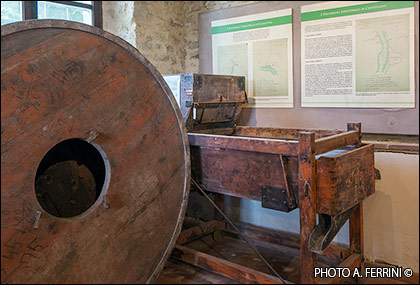 We have to follow the paved road for two hundred meters towards Chiusi della Verna. We will find, on the left, a pine forest with the indication "ferruginous water". From here a path inside a thick wood takes us down to a crossroads in ten minutes where we must keep to the right. In a few minutes we reach a steep, and therefore noisy stream, the Rio torrent, which we will cross with a footbridge. A few more minutes of walking and we arrive at the Rassina torrent, wider than the previous one. Along its left bank, ten meters upstream from where we arrived, is the ferruginous spring. The ground and the rusty-red stones clearly indicate it to us. From the upper part of the town we return to the lower one. A few meters from the church of Santi Vincenzo e Pietro begins a road that descends to the stream. Before crossing it, on the left, there is the "Buca del Tesoro". A park that we will talk about at the end of this text. Continuing we will reach Rosina and Taena, two small villages inserted in an agricultural context whose toponyms allow you to easily guess their Etruscan origins. Villages that take us back to a time that was, with interesting architectural elements on the buildings. The small churches of these localities, respectively dedicated to Santa Margherita and San Jacopo, are worthy of attention. Their shape and the stones, large and well squared, take us far back in time, in fact they are indicated as dating back to the 11th century. From Rosina in two kilometers you go up to Croce di Sarna. A town that has no particular things to show but which offers a beautiful view of Chitignano and the valley that heads towards Arezzo. In clear conditions we can distinguish the unmistakable profile of Monte Amiata. On the opposite side we will see Bibbiena and the upper Casentino. A small village on the apex of the opposite hill will strike our attention. It is the Castle of Sarna, which can be reached from here in one kilometre. A place of medieval origin without a doubt to visit, even if we have entered the Municipality of Chiusi della Verna.
We have to follow the paved road for two hundred meters towards Chiusi della Verna. We will find, on the left, a pine forest with the indication "ferruginous water". From here a path inside a thick wood takes us down to a crossroads in ten minutes where we must keep to the right. In a few minutes we reach a steep, and therefore noisy stream, the Rio torrent, which we will cross with a footbridge. A few more minutes of walking and we arrive at the Rassina torrent, wider than the previous one. Along its left bank, ten meters upstream from where we arrived, is the ferruginous spring. The ground and the rusty-red stones clearly indicate it to us. From the upper part of the town we return to the lower one. A few meters from the church of Santi Vincenzo e Pietro begins a road that descends to the stream. Before crossing it, on the left, there is the "Buca del Tesoro". A park that we will talk about at the end of this text. Continuing we will reach Rosina and Taena, two small villages inserted in an agricultural context whose toponyms allow you to easily guess their Etruscan origins. Villages that take us back to a time that was, with interesting architectural elements on the buildings. The small churches of these localities, respectively dedicated to Santa Margherita and San Jacopo, are worthy of attention. Their shape and the stones, large and well squared, take us far back in time, in fact they are indicated as dating back to the 11th century. From Rosina in two kilometers you go up to Croce di Sarna. A town that has no particular things to show but which offers a beautiful view of Chitignano and the valley that heads towards Arezzo. In clear conditions we can distinguish the unmistakable profile of Monte Amiata. On the opposite side we will see Bibbiena and the upper Casentino. A small village on the apex of the opposite hill will strike our attention. It is the Castle of Sarna, which can be reached from here in one kilometre. A place of medieval origin without a doubt to visit, even if we have entered the Municipality of Chiusi della Verna. 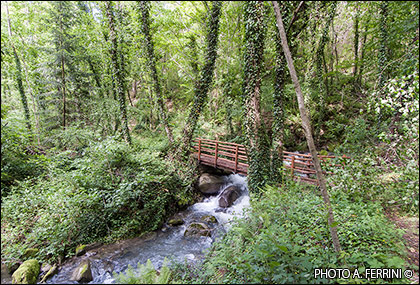 At the beginning of this text we mentioned the Hermitage of Casella. Located on the Alpe di Catenaia at 1265 meters above sea level, it can be reached from Chitignano in about seven kilometers on foot via the CAI 028 route which starts in front of the church of San Lorenzo. We can reduce the walk by using the road that starts next to the CAI 028. This is easily passable for 1.4 kilometers with a normal car, then it becomes a forest road, you need a suitable vehicle. After 4.1 kilometres, the road ends in a space which is also a crossroads. Here we find the CAI 028 (central route closed by a chain) which for three hundred meters rises decisively on stony ground. Then turn left and, on a level path, enter a splendid forest made up mostly of beech trees, but we will also find firs, ash trees and Turkey oaks. Gradually, fresh streams will make us listen to their murmur. This wonderful natural scenery in just over two kilometers leads us to the crossroads with the CAI 50, on the ridge of Alpe di Catenaia. We take this route on the left which in 1.7 kilometers leads us to the Casella. From the meadow adjacent to the hermitage we have a beautiful view of the Valtiberina, unmistakable due to the reservoir of Montedoglio, the largest lake in Tuscany. The chapel and hermitage of Casella, restored in 1987, have origins dating back to the second half of the 15th century. They were built to commemorate a pause for prayer and greeting at La Verna that San Francesco made here on 30 September 1224 when he left his beloved mountain for the last time. At the end of the 19th century, Emma Perodi with her wild imagination created a pleasant link between Chitignano and the Casella Hermitage. The writer from Cerreto Guidi, among her Novelle della Nonna, also known as Tuscan Tales: the fantastic fables of Emma Perodi, wrote one entitled Il Romito dell’Alpe di Catenaia. In the tale, it is told that on an unspecified day many years ago, a young knight arrived at Casella. He had no servants in tow and did not display the exuberance typical of such figures; on the contrary, he appeared very humble. Dismissing his stately clothes, he made a habit of a monk’s tunic. For his few alimentary needs, he went down to Chitignano from time to time. He was a reserved person, at the same time kind and respectful towards others. He devoted himself with much love to the sick children, whom he was often able to heal. When he could not, he was able to find very comforting words to ease their parents’ pain. One night the hermit had a dream, in which he saw abundant water with healing properties flowing from a spring near the village.
At the beginning of this text we mentioned the Hermitage of Casella. Located on the Alpe di Catenaia at 1265 meters above sea level, it can be reached from Chitignano in about seven kilometers on foot via the CAI 028 route which starts in front of the church of San Lorenzo. We can reduce the walk by using the road that starts next to the CAI 028. This is easily passable for 1.4 kilometers with a normal car, then it becomes a forest road, you need a suitable vehicle. After 4.1 kilometres, the road ends in a space which is also a crossroads. Here we find the CAI 028 (central route closed by a chain) which for three hundred meters rises decisively on stony ground. Then turn left and, on a level path, enter a splendid forest made up mostly of beech trees, but we will also find firs, ash trees and Turkey oaks. Gradually, fresh streams will make us listen to their murmur. This wonderful natural scenery in just over two kilometers leads us to the crossroads with the CAI 50, on the ridge of Alpe di Catenaia. We take this route on the left which in 1.7 kilometers leads us to the Casella. From the meadow adjacent to the hermitage we have a beautiful view of the Valtiberina, unmistakable due to the reservoir of Montedoglio, the largest lake in Tuscany. The chapel and hermitage of Casella, restored in 1987, have origins dating back to the second half of the 15th century. They were built to commemorate a pause for prayer and greeting at La Verna that San Francesco made here on 30 September 1224 when he left his beloved mountain for the last time. At the end of the 19th century, Emma Perodi with her wild imagination created a pleasant link between Chitignano and the Casella Hermitage. The writer from Cerreto Guidi, among her Novelle della Nonna, also known as Tuscan Tales: the fantastic fables of Emma Perodi, wrote one entitled Il Romito dell’Alpe di Catenaia. In the tale, it is told that on an unspecified day many years ago, a young knight arrived at Casella. He had no servants in tow and did not display the exuberance typical of such figures; on the contrary, he appeared very humble. Dismissing his stately clothes, he made a habit of a monk’s tunic. For his few alimentary needs, he went down to Chitignano from time to time. He was a reserved person, at the same time kind and respectful towards others. He devoted himself with much love to the sick children, whom he was often able to heal. When he could not, he was able to find very comforting words to ease their parents’ pain. One night the hermit had a dream, in which he saw abundant water with healing properties flowing from a spring near the village. 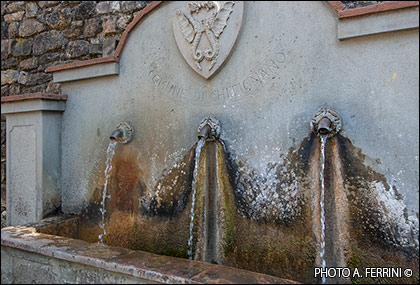 The following day he went down to Chitignano to look for that spring, which he found near the stream. That water really did heal many people, so it was of great value. This is the reason why that place that gave such a precious good to the community was called Buca del Tesoro (Treasure Hole). That spring discovered by Romito dell'Alpe di Catenaia is still there, with the same name. When we return from the excursion to the Eremo della Casella or from the walk to the ferruginous water, but also during a visit to Chitignano, let's not forget to stop by and taste the ferruginous sulphurous flavor of that water. At the same time we will benefit from its purifying properties. The Buca del Tesoro is a park with a large lawn and games for children, an ideal environment for families. It is also an area equipped for lunches, snacks and dinners in a cool place surrounded by greenery. There is no shortage of water, even non-thermal. There is also a small kiosk able to prepare specialties instantly to be enjoyed in complete relaxation. The first 42 pages of the sequence, each with photos and descriptions, are a virtual visit to the municipal territory of Chitignano. From page 43 to 54 describe the short walk that leads from the ecomuseum to a smugglers' "pillo" and then to the spring of ferruginous water. From page 55 to 80 the two possibilities are shown for reaching the Eremo della Casella starting from Chitignano with a possible detour to go and see the remains of the first castle of Chitignano.
The following day he went down to Chitignano to look for that spring, which he found near the stream. That water really did heal many people, so it was of great value. This is the reason why that place that gave such a precious good to the community was called Buca del Tesoro (Treasure Hole). That spring discovered by Romito dell'Alpe di Catenaia is still there, with the same name. When we return from the excursion to the Eremo della Casella or from the walk to the ferruginous water, but also during a visit to Chitignano, let's not forget to stop by and taste the ferruginous sulphurous flavor of that water. At the same time we will benefit from its purifying properties. The Buca del Tesoro is a park with a large lawn and games for children, an ideal environment for families. It is also an area equipped for lunches, snacks and dinners in a cool place surrounded by greenery. There is no shortage of water, even non-thermal. There is also a small kiosk able to prepare specialties instantly to be enjoyed in complete relaxation. The first 42 pages of the sequence, each with photos and descriptions, are a virtual visit to the municipal territory of Chitignano. From page 43 to 54 describe the short walk that leads from the ecomuseum to a smugglers' "pillo" and then to the spring of ferruginous water. From page 55 to 80 the two possibilities are shown for reaching the Eremo della Casella starting from Chitignano with a possible detour to go and see the remains of the first castle of Chitignano.



